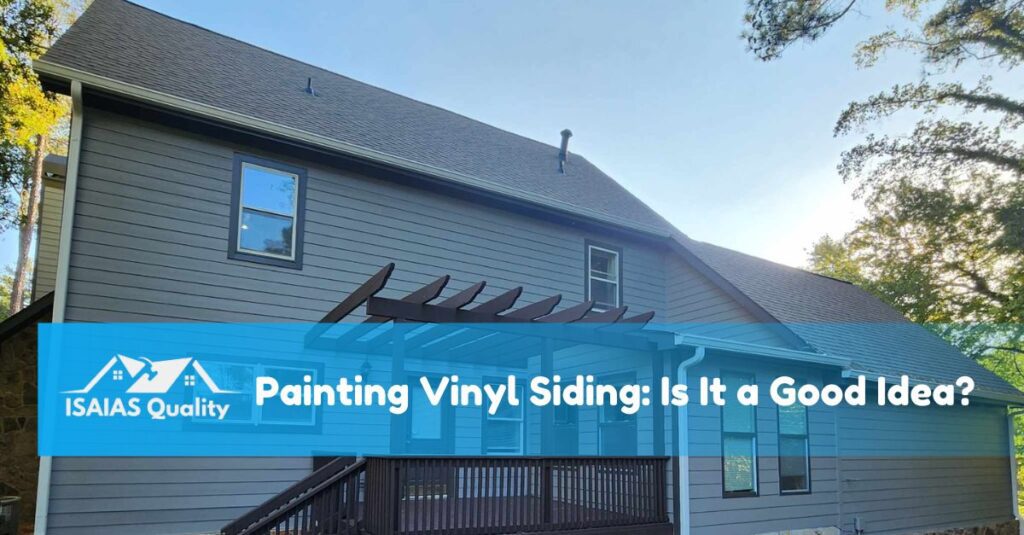
Vinyl siding is a popular choice for homeowners due to its durability, affordability, and low maintenance requirements. However, over time, exposure to the elements can cause it to fade, making your home look outdated. If your vinyl siding is still in good condition but has lost its original appeal, you may be wondering: Can you paint vinyl siding? And is it a good idea?
Painting vinyl siding is a cost-effective alternative to replacement, but it comes with pros and cons. This guide will help you determine whether painting your vinyl siding is the right decision, explain the best techniques for achieving a professional finish, and provide maintenance tips to ensure long-lasting results.
Can You Paint Vinyl Siding?
Yes, you can paint vinyl siding, but there are a few critical factors to consider before picking up a brush. Unlike wood or brick, vinyl is not a porous material, meaning it requires specialized paint to adhere properly. Additionally, the color you choose must be compatible with vinyl siding to prevent warping due to heat absorption.
While painting is possible, it’s not always the best solution. Let’s explore the advantages and disadvantages to help you decide if painting is right for your home.
Pros of Painting Vinyl Siding
1. Cost-Effective Solution
Replacing vinyl siding can be expensive, often costing anywhere from $10,000 to $20,000 for a full installation. In contrast, painting is significantly cheaper, with a professional paint job typically ranging from $3,000 to $5,000, depending on the size of your home. If you choose to do it yourself, the cost may be as low as $500 to $1,500 for materials.
2. Aesthetic Upgrade
Painting allows you to change the color of your home without the commitment of replacing siding. If your home’s exterior looks faded or outdated, a fresh coat of paint can restore its appearance and increase curb appeal.
3. Customization Options
When you originally installed your vinyl siding, you may have had limited color choices. Painting offers endless possibilities, allowing you to select any shade that fits your style and complements your home’s architecture.
4. Extends the Life of Your Siding
If your siding is structurally sound but has lost its vibrancy, painting can help extend its lifespan. Properly applied paint can protect against UV rays, moisture, and other environmental factors that cause deterioration.
5. Environmentally Friendly
Replacing vinyl siding results in waste that often ends up in landfills. By repainting rather than replacing, you reduce waste and minimize the environmental impact of your home improvement project.
Cons of Painting Vinyl Siding
1. Potential for Warping
Vinyl expands and contracts with temperature changes. If you choose a color darker than the original, it will absorb more heat, increasing the risk of warping or buckling. This can lead to permanent damage that may require replacement.
2. Requires Proper Preparation
Unlike painting wood, painting vinyl requires extensive prep work. The surface must be thoroughly cleaned to remove dirt, mildew, and oxidation before applying paint. Skipping this step can result in peeling and uneven coverage.
3. Limited Paint Choices
Not all paints are suitable for vinyl siding. You must use high-quality acrylic latex paint specifically designed for exterior vinyl surfaces. Additionally, some siding manufacturers void warranties if the siding is painted, so it’s essential to check before proceeding.
4. Shorter Lifespan Compared to New Siding
While a properly painted surface can last up to 10 years, it won’t last as long as new vinyl siding, which can have a lifespan of 20–40 years. Over time, you may need to repaint, adding to long-term maintenance costs.
5. Time-Consuming Process
Painting vinyl siding isn’t a quick weekend project. Cleaning, priming (if necessary), and applying multiple coats of paint take time. If you’re hiring professionals, labor costs can add up, reducing the overall savings compared to replacing the siding.
How to Paint Vinyl Siding the Right Way
If you decide to move forward with painting, follow these steps for the best results:
Step 1: Choose the Right Paint
Selecting the right paint is crucial for longevity and durability. Use a high-quality acrylic latex exterior paint designed for vinyl siding. Some recommended options include:
- Sherwin-Williams VinylSafe
- Benjamin Moore Regal Select
- Behr Premium Plus Ultra
Avoid oil-based or dark-colored paints, as they can cause overheating and warping.
Step 2: Clean the Siding Thoroughly
Dirt, grime, and mildew can prevent paint from adhering properly. Clean your siding using one of the following methods:
- Power Washing – Fast and effective, but use a low-pressure setting to avoid damage.
- Soap and Water Mixture – A solution of water, mild detergent, and a bit of bleach can remove mildew.
- Trisodium Phosphate (TSP) – Ideal for removing chalky oxidation buildup.
Allow the siding to dry completely before painting.
Step 3: Apply a Primer (If Necessary)
Many modern paints are self-priming, but if your siding is heavily oxidized or a drastic color change is needed, apply a vinyl-safe primer for better adhesion.
Step 4: Use a Paint Sprayer or Roller
For the smoothest finish:
- Use a paint sprayer for an even, professional-looking application.
- Use a high-quality roller if a sprayer isn’t available. Apply two thin coats instead of one thick coat to prevent drips and streaks.
Step 5: Allow Proper Drying Time
Follow the manufacturer’s instructions for drying time between coats. Avoid painting in extreme heat, humidity, or direct sunlight for the best results.
Maintaining Painted Vinyl Siding
To keep your painted siding looking fresh:
- Wash Annually – Use a garden hose or mild detergent to remove dirt and grime.
- Inspect for Peeling – If you notice peeling or chipping, touch up those areas promptly.
- Avoid Harsh Chemicals – Stay away from abrasive cleaners that could damage the paint.
Should You Paint or Replace Your Vinyl Siding?
| Factors | Painting Vinyl Siding | Replacing Vinyl Siding |
|---|---|---|
| Cost | $3,000–$5,000 (professional) | $10,000–$20,000 |
| Lifespan | 5–10 years | 20–40 years |
| Customization | Wide range of colors | Limited to manufacturer options |
| Warranty | May void existing warranty | New warranty included |
| Maintenance | Requires touch-ups over time | Minimal maintenance |
| Eco-Friendliness | Reduces waste | Generates landfill waste |
If your vinyl siding is in good condition but needs a visual refresh, painting is a cost-effective and eco-friendly choice. However, if your siding is old, cracked, or warped, replacement may be the better long-term investment.
Final Thoughts
Painting vinyl siding can be a great way to update your home’s appearance without the hefty price tag of replacement. However, proper preparation, the right paint, and careful maintenance are essential to ensure long-lasting results. If done correctly, painting can enhance curb appeal and extend the life of your siding.
Before making a decision, weigh the pros and cons based on your home’s condition, budget, and long-term goals. Whether you choose to paint or replace, keeping your home’s exterior well-maintained will improve its value and appearance for years to come.
Would you consider painting your vinyl siding, or do you prefer a full replacement? Let us know in the comments!




